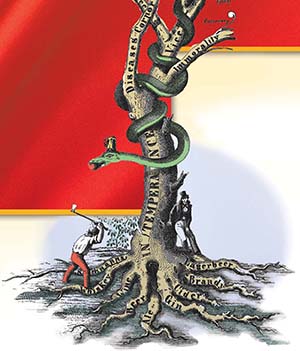SECTION 2: A Reforming Society

▲ A print promoting the temperance cause, 1855
WITNESS HISTORY  AUDIO
AUDIO
Improving Society
In the early and middle 1800s, Americans became involved in a wide variety of reform movements, ranging from helping society’s disadvantaged to trying to control alcohol abuse. Ralph Waldo Emerson eloquently expressed the feelings of many:
“[T]he idea which now begins to agitate society has a wider scope than our daily employments, our households, and the institutions of property. We are [going] to revise the whole of our social structure, the state, the school, religion, marriage, trade, science, and explore the foundations in our own nature…. What is a man born for but to be a Reformer, a Remaker …?”
—Ralph Waldo Emerson, “Man the Reformer,” 1841
Objectives
- Describe the public school movement.
- Describe how reformers tried to improve the condition of prisoners and people with mental illness.
- Evaluate the effectiveness of the temperance movement.
Terms and People
- public school movement
- Horace Mann
- Dorothea Dix
- penitentiary movement
- temperance movement
- Neal Dow
NoteTaking
Reading Skill: Understand Effects As you read, note the different problems facing society in the early 1800s, what reformers did to address each problem, and the effects of their efforts.
| Causes | Efforts to Reform | Results |
|---|---|---|
| Educating all Americans | ||
Why It Matters Many Americans embraced religion during the Second Great Awakening. Soon, many of these people began to put their religious ideals into practice by working to reshape, or reform, parts of American life. Their efforts would impact several groups of the most disadvantaged Americans. Section Focus Question: What were the main features of the public school, penitentiary, and temperance reform movements?
Reforming Education
The leaders of the Second Great Awakening preached that their followers had a sacred responsibility to improve life on Earth through reform, especially for the disadvantaged. Not all reformers were motivated by religion. Many were simply moved by the suffering they saw. One of most popular reform movements was in the field of education.
Reformers Value Education
Since colonial times, most American children had been taught at home by their parents. Some communities established schools. The American Spelling Book, created by Noah Webster in the 1780s, remained the most popular school-book. Webster developed special spelling forms that he felt were representative of America’s honesty and directness, emphasizing America’s differences from England.
Still, reformers saw education in America as woefully inadequate. Because there were no public schools that children were




